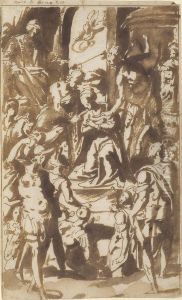Marco Marchetti Paintings
Marco Marchetti, also known as Marco da Faenza after his place of birth (Faenza, Italy), was an Italian painter active during the Renaissance period. Marchetti was born in 1528 into an era where the Italian Renaissance was flourishing, and he became known for his work in both oil painting and fresco.
Marchetti initially trained under the guidance of Francesco Menzocchi, a prominent painter from Forlì. His early works exhibit the influence of his teacher and other contemporaries, displaying the typical characteristics of the late Renaissance style, with a balanced composition and a focus on harmony and beauty.
Marco Marchetti's career took him to different parts of Italy, where he worked on various commissions. One of his most significant contributions was to the decoration of the Palazzo Vecchio in Florence, where he collaborated with Giorgio Vasari, one of the leading artists and art historians of the time. Marchetti's work in the Palazzo Vecchio involved contributing to the frescoes with both his design and painting skills.
In addition to his frescoes, Marchetti's oil paintings also gained recognition. His ability to depict religious and mythological subjects with a delicate sense of color and detail was particularly admired. Marchetti's artistry was not limited to grand projects; he also painted smaller scale works for private devotion and collectors.
Despite his talent and contributions, Marco Marchetti did not gain the same level of fame as some of his contemporaries like Michelangelo or Raphael. However, his works were still sought after, and he enjoyed the patronage of notable figures of his time.
Marchetti's later years saw him continue to work on important commissions. His last known work dates back to 1588, the same year he passed away. His death marked the end of a career that, while not as well-remembered as some of his peers, played a role in the rich tapestry of Renaissance art. Marchetti's works can still be seen in various Italian churches and museums, providing insight into the lesser-known but skilled artists of the period.
